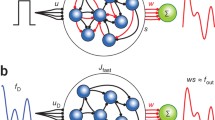Abstract
We briefly discuss variants of (extended) spiking neural P systems that combine features from the areas of membrane computing and spiking neurons.
Similar content being viewed by others
Explore related subjects
Discover the latest articles, news and stories from top researchers in related subjects.References
Păun Gh (1998) Computing with membranes. Journal of Computer and System Sciences 61(1):108–143 and TUCS Research Report 208 (1998) (http://www.tucs.fi)
Păun Gh (2002) Computing with membranes: an introduction. Springer, Berlin
The P systems webpage, http://psystems.disco.unimib.it
Martín-Vide C, Pazos J, Păun Gh, et al (2003) Tissue P systems. Theor Comput Sci 296:295–326
Gerstner W, Kistler W (2002) Spiking neuron models. Single neurons, populations, plasticity. Cambridge University Press, Cambridge
Maass W (2002) Computing with spikes. Special Issue on Foundations of Information Processing of TELEMATIK 8(1):32–36
Maass W, Bishop C (eds) (1999) Pulsed neural networks. MIT Press, Cambridge
Ionescu M, Păun Gh, Yokomori T (2006) Spiking neural P systems. Fundamenta Informaticae 71:279–308
Păun Gh (2007) Spiking neural P systems. A tutorial. Bull EATCS 91:145–159
Alhazov A, Freund R, Oswald M, et al (2007) Extended spiking neural P systems generating strings and vectors of non-negative integers. In: Hoogeboom HJ, Păun Gh, Rozenberg G (eds) Membrane computing. 7th International Workshop, WMC7, Springer, Berlin, pp 123–134
Freund R, Oswald M (2007) Extended spiking neural P systems with inhibitory axons. In: Sugisaka M, Tanaka H (eds) Proceedings of the 12th International Symposium on Artificial Life and Robotics, AROB12th 2007, Beppu, Oita, Japan, pp 509–512
Binder A, Freund R, Oswald M, et al (2007) Extended spiking neural P systems with excitatory and inhibitory astrocytes. Proceedings of the 8th WSEAS Conference on Evolutionary Comput ing, Lecture Notes in Computational Intelligence, Vancouver, Canada, pp 88–101
Perea G, Araque A (2002) Communication between astrocytes and neurons: a complex language. J Physiol Paris 96:199–207
Shen X, de Wilde P (2007) Long-term neuronal behavior caused by two synaptic modification mechanisms. Neurocomputing 70(7–9):1482–1488
Binder A, Freund R, Oswald M (2008) Extended spiking neural P systems with astrocytes: variants for modelling the brain. Proceedings of the 13th International Symposium on Artificial Life and Robotics AROB13th 2008, Beppu, Oita, Japan, pp 520–524
Buarque de Lima Neto F, de Wilde P (2006) Venn-like models of neocortex patches. International Joint Conference on Neural Networks, pp 89–96
Ibarra OH, Păun A, Păun Gh, et al (2006) Normal forms for spiking neural P systems. 4th Brainstorming Week on Membrane Computing, vol II, RGNC REPORT 02/2006, Fénix Editora, Seville, pp 105–136
Freund R, Ionescu M, Oswald M (2007) Extended spiking neural P systems with decaying spikes and/or total spiking. In: Vaszil Gy (ed) Automata for Cellular and Molecular Computing. MTA Sztaki, Budapest, pp 64–76
Cavaliere M, Egecioglu O, Ibarra OH, et al (2007) Asynchronous spiking neural P systems. Tech Rep 9/2007, Microsoft Research, University of Trento, Centre for Computational and Systems Biology
Ionescu M, Sburlan D (2007) Some applications of spiking neural P systems. Pre-proceedings of the Membrane Computing, International Workshop (WMC8), Thessaloniki, Greece, pp 383–394
Leporati A, Zandron C, Ferretti C, et al (2007) Solving numerical NP-complete problems with spiking neural P systems. Preproceedings of the Membrane Computing International Workshop (WMC8), Thessaloniki, Greece, pp 405–424
Păun Gh (2007) Twenty-six research topics about spiking neural P systems. Available at ref. 3
Author information
Authors and Affiliations
Corresponding author
Additional information
This work was presented in part at the 13th International Symposium on Artificial Life and Robotics, Oita, Japan, January 31–February 2, 2008
About this article
Cite this article
Oswald, M. Membrane computing and brain modelling. Artif Life Robotics 13, 390–393 (2009). https://doi.org/10.1007/s10015-008-0619-0
Received:
Accepted:
Published:
Issue Date:
DOI: https://doi.org/10.1007/s10015-008-0619-0




